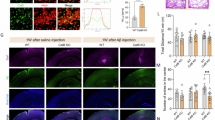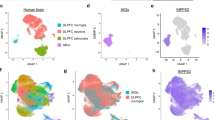Abstract
Activation of microglia and inflammation-mediated neurotoxicity are suggested to play a decisive role in the pathogenesis of several neurodegenerative disorders. Activated microglia release pro-inflammatory factors that may be neurotoxic. Here we show that the orderly activation of caspase-8 and caspase-3/7, known executioners of apoptotic cell death, regulate microglia activation through a protein kinase C (PKC)-δ-dependent pathway. We find that stimulation of microglia with various inflammogens activates caspase-8 and caspase-3/7 in microglia without triggering cell death in vitro and in vivo. Knockdown or chemical inhibition of each of these caspases hindered microglia activation and consequently reduced neurotoxicity. We observe that these caspases are activated in microglia in the ventral mesencephalon of Parkinson’s disease (PD) and the frontal cortex of individuals with Alzheimer’s disease (AD). Taken together, we show that caspase-8 and caspase-3/7 are involved in regulating microglia activation. We conclude that inhibition of these caspases could be neuroprotective by targeting the microglia rather than the neurons themselves.
This is a preview of subscription content, access via your institution
Access options
Subscribe to this journal
Receive 51 print issues and online access
$199.00 per year
only $3.90 per issue
Buy this article
- Purchase on SpringerLink
- Instant access to full article PDF
Prices may be subject to local taxes which are calculated during checkout






Similar content being viewed by others
References
Hanisch, U. K. & Kettenmann, H. Microglia: active sensor and versatile effector cells in the normal and pathologic brain. Nature Neurosci. 10, 1387–1394 (2007)
Block, M. L., Zecca, L. & Hong, J. S. Microglia-mediated neurotoxicity: uncovering the molecular mechanisms. Nature Rev. Neurosci. 8, 57–69 (2007)
Chao, C. C., Hu, S., Molitor, T. W., Shaskan, E. G. & Peterson, P. K. Activated microglia mediate neuronal cell injury via a nitric oxide mechanism. J. Immunol. 149, 2736–2741 (1992)
Castano, A., Herrera, A. J., Cano, J. & Machado, A. Lipopolysaccharide intranigral injection induces inflammatory reaction and damage in nigrostriatal dopaminergic system. J. Neurochem. 70, 1584–1592 (1998)
Saijo, K. et al. A Nurr1/CoREST pathway in microglia and astrocytes protects dopaminergic neurons from inflammation-induced death. Cell 137, 47–59 (2009)
Zhao, J. et al. IRF-8/interferon (IFN) consensus sequence-binding protein is involved in Toll-like receptor (TLR) signaling and contributes to the cross-talk between TLR and IFN-gamma signaling pathways. J. Biol. Chem. 281, 10073–10080 (2006)
Car, B. D. et al. Interferon gamma receptor deficient mice are resistant to endotoxic shock. J. Exp. Med. 179, 1437–1444 (1994)
Jin, J. J., Kim, H. D., Maxwell, J. A., Li, L. & Fukuchi, K. Toll-like receptor 4-dependent upregulation of cytokines in a transgenic mouse model of Alzheimer’s disease. J. Neuroinflammation 5, 23 (2008)
Balistreri, C. R. et al. Association between the polymorphisms of TLR4 and CD14 genes and Alzheimer’s disease. Curr. Pharm. Des. 14, 2672–2677 (2008)
Walter, S. et al. Role of the toll-like receptor 4 in neuroinflammation in Alzheimer’s disease. Cell. Physiol. Biochem. 20, 947–956 (2007)
Nicholson, D. W. et al. Identification and inhibition of the ICE/CED-3 protease necessary for mammalian apoptosis. Nature 376, 37–43 (1995)
Cohen, G. M. Caspases: the executioners of apoptosis. Biochem. J. 326, 1–16 (1997)
Keller, M., Ruegg, A., Werner, S. & Beer, H. D. Active caspase-1 is a regulator of unconventional protein secretion. Cell 132, 818–831 (2008)
Schulz, J. B. et al. Extended therapeutic window for caspase inhibition and synergy with MK-801 in the treatment of cerebral histotoxic hypoxia. Cell Death Differ. 5, 847–857 (1998)
Braun, J. S. et al. Neuroprotection by a caspase inhibitor in acute bacterial meningitis. Nature Med. 5, 298–302 (1999)
Cutillas, B., Espejo, M., Gil, J., Ferrer, I. & Ambrosio, S. Caspase inhibition protects nigral neurons against 6-OHDA-induced retrograde degeneration. Neuroreport 10, 2605–2608 (1999)
Depino, A. M. et al. Microglial activation with atypical proinflammatory cytokine expression in a rat model of Parkinson’s disease. Eur. J. Neurosci. 18, 2731–2742 (2003)
Kawai, T. & Akira, S. Signaling to NF-κB by Toll-like receptors. Trends Mol. Med. 13, 460–469 (2007)
Gibbons, H. M. & Dragunow, M. Microglia induce neural cell death via a proximity-dependent mechanism involving nitric oxide. Brain Res. 1084, 1–15 (2006)
Schumann, R. R. et al. Lipopolysaccharide activates caspase-1 (interleukin-1-converting enzyme) in cultured monocytic and endothelial cells. Blood 91, 577–584 (1998)
Li, P. et al. Mice deficient in IL-1β-converting enzyme are defective in production of mature IL-1β and resistant to endotoxic shock. Cell 80, 401–411 (1995)
Friedlander, R. M. et al. Expression of a dominant negative mutant of interleukin-1β converting enzyme in transgenic mice prevents neuronal cell death induced by trophic factor withdrawal and ischemic brain injury. J. Exp. Med. 185, 933–940 (1997)
Fernandes-Alnemri, T. et al. In vitro activation of CPP32 and Mch3 by Mch4, a novel human apoptotic cysteine protease containing two FADD-like domains. Proc. Natl Acad. Sci. USA 93, 7464–7469 (1996)
Nunez, G., Benedict, M. A., Hu, Y. & Inohara, N. Caspases: the proteases of the apoptotic pathway. Oncogene 17, 3237–3245 (1998)
Slee, E. A., Adrain, C. & Martin, S. J. Serial killers: ordering caspase activation events in apoptosis. Cell Death Differ. 6, 1067–1074 (1999)
Aliprantis, A. O., Yang, R. B., Weiss, D. S., Godowski, P. & Zychlinsky, A. The apoptotic signaling pathway activated by Toll-like receptor-2. EMBO J. 19, 3325–3336 (2000)
Jung, D. Y. et al. TLR4, but not TLR2, signals autoregulatory apoptosis of cultured microglia: a critical role of IFN-beta as a decision maker. J. Immunol. 174, 6467–6476 (2005)
Kuno, R. et al. Autocrine activation of microglia by tumor necrosis factor-alpha. J. Neuroimmunol. 162, 89–96 (2005)
Storz, P., Doppler, H. & Toker, A. Protein kinase Cdelta selectively regulates protein kinase D-dependent activation of NF-κB in oxidative stress signaling. Mol. Cell. Biol. 24, 2614–2626 (2004)
Vancurova, I., Miskolci, V. & Davidson, D. NF-κB activation in tumor necrosis factor α-stimulated neutrophils is mediated by protein kinase Cδ. Correlation to nuclear IκBα. J. Biol. Chem. 276, 19746–19752 (2001)
Reyland, M. E., Anderson, S. M., Matassa, A. A., Barzen, K. A. & Quissell, D. O. Protein kinase Cδ is essential for etoposide-induced apoptosis in salivary gland acinar cells. J. Biol. Chem. 274, 19115–19123 (1999)
Czlonkowska, A., Kohutnicka, M., Kurkowska-Jastrzebska, I. & Czlonkowski, A. Microglial reaction in MPTP (1-methyl-4-phenyl-1,2,3,6-tetrahydropyridine) induced Parkinson’s disease mice model. Neurodegeneration 5, 137–143 (1996)
Aarli, J. A. Role of cytokines in neurological disorders. Curr. Med. Chem. 10, 1931–1937 (2003)
Gonzalez-Scarano, F. & Baltuch, G. Microglia as mediators of inflammatory and degenerative diseases. Annu. Rev. Neurosci. 22, 219–240 (1999)
Jordan, J., Segura, T., Brea, D., Galindo, M. F. & Castillo, J. Inflammation as therapeutic objective in stroke. Curr. Pharm. Des. 14, 3549–3564 (2008)
Lenzlinger, P. M., Morganti-Kossmann, M. C., Laurer, H. L. & McIntosh, T. K. The duality of the inflammatory response to traumatic brain injury. Mol. Neurobiol. 24, 169–181 (2001)
Allan, S. M. & Rothwell, N. J. Inflammation in central nervous system injury. Phil. Trans. R. Soc. Lond. B 358, 1669–1677 (2003)
Karatas, H. et al. A nanomedicine transports a peptide caspase-3 inhibitor across the blood-brain barrier and provides neuroprotection. J. Neurosci. 29, 13761–13769 (2009)
Bilsland, J. & Harper, S. Caspases and neuroprotection. Curr. Opin. Investig. Drugs 3, 1745–1752 (2002)
Friedlander, R. M. Apoptosis and caspases in neurodegenerative diseases. N. Engl. J. Med. 348, 1365–1375 (2003)
Le, D. A. et al. Caspase activation and neuroprotection in caspase-3-deficient mice after in vivo cerebral ischemia and in vitro oxygen glucose deprivation. Proc. Natl Acad. Sci. USA 99, 15188–15193 (2002)
Joseph, B. et al. p57(Kip2) cooperates with Nurr1 in developing dopamine cells. Proc. Natl Acad. Sci. USA 100, 15619–15624 (2003)
Bocchini, V. et al. An immortalized cell line expresses properties of activated microglial cells. J. Neurosci. Res. 31, 616–621 (1992)
Giulian, D. & Baker, T. J. Characterization of ameboid microglia isolated from developing mammalian brain. J. Neurosci. 6, 2163–2178 (1986)
Li, J. Y. et al. Lewy bodies in grafted neurons in subjects with Parkinson’s disease suggest host-to-graft disease propagation. Nature Med. 14, 501–503 (2008)
Joseph, B. et al. Mitochondrial dysfunction is an essential step for killing of non-small cell lung carcinomas resistant to conventional treatment. Oncogene 21, 65–77 (2002)
Rite, I., Machado, A., Cano, J. & Venero, J. L. Blood-brain barrier disruption induces in vivo degeneration of nigral dopaminergic neurons. J. Neurochem. 101, 1567–1582 (2007)
Acknowledgements
We thank A. Gorman, O. Hermanson, M. Malewicz, S. Orrenius, T. Panaretakis and B. Zhivotovsky for discussion, and L. Hjortsberg, M. Reyland and S. Ceccatelli for providing us with reagents. M. Carballo, JL. Ribas, A. Fernández and B. Haraldsson provided qualified technical support. This work has been supported by grants from the Spanish Ministerio de Ciencia y Tecnología (SAF2006-04119 and 2009-13778), the Swedish Research Council, the Parkinson Foundation of Sweden, the Swedish Alzheimer Foundation and the Swedish Cancer Society. M.A.B., T.D. and P.B. are members of Neurofortis and Bagadilico, both of which are research environments sponsored by the Swedish Research Council.
Author information
Authors and Affiliations
Contributions
M.A.B. performed all the experiments except as otherwise noted. qPCR was performed by A.G.-Q. and E.K. J.L.V. and J.C. collaborated in doing surgery and further dissecting the animal brains. M.A.B. and T.D. performed primary cell culture experiments and cytokine analysis. E.K. collaborated in performing the caspase activity assay. B.J. and E.K. collaborated in performing FACS. B.J. collaborated also in the confocal imaging analysis. E.E. did the neuropathology of the individuals with PD and AD and the controls. A.P. prepared tissue and participated in the morphological assessment of human brain specimens. N.H. and P.B. were involved in study design. M.A.B., J.L.V. and B.J. designed the study, analysed and interpreted the data. All authors discussed the results and commented on or edited the manuscript. The first draft of the paper was written by B.J. J.L.V. and B.J. share senior authorship of the paper. T.D and E.K. share second authorship.
Corresponding authors
Ethics declarations
Competing interests
The authors declare no competing financial interests.
Supplementary information
Supplementary Information
This file contains Supplementary Figures 1-20 with legends, Supplementary Tables 1-3 and legends for Supplementary Movies 1-2. (PDF 20300 kb)
Supplementary Movie 1
This movie shows 3D confocal analysis of cleaved caspase-3 (in green) in lipopolysaccharide treated BV2 microglia cells. Nuclear and plasma membrane compartments were labeled with DAPI (Blue) and red fluorescent cholera toxin subunit B conjugates respectively. LPS-induced caspase-3 activation in BV2 microglia cells is restricted to plasma membrane compartment. (MOV 1592 kb)
Supplementary Movie 2
This movie shows 3D confocal analysis of cleaved caspase-3 (in green) in staurospaurine treated BV2 microglia cells. Nuclear and plasma membrane compartments were labeled with DAPI (Blue) and red fluorescent cholera toxin subunit B conjugates respectively. STS-induced caspase-3 activation in BV2 microglia cells accumulates in the nuclear compartment. (MOV 1349 kb)
Rights and permissions
About this article
Cite this article
Burguillos, M., Deierborg, T., Kavanagh, E. et al. Caspase signalling controls microglia activation and neurotoxicity. Nature 472, 319–324 (2011). https://doi.org/10.1038/nature09788
Received:
Accepted:
Published:
Issue Date:
DOI: https://doi.org/10.1038/nature09788
This article is cited by
-
Review of lipocalin-2-mediated effects in diabetic retinopathy
International Ophthalmology (2024)
-
Lactiplantibacillus plantarum X7022 Plays Roles on Aging Mice with Memory Impairment Induced by D-Galactose Through Restoring Neuronal Damage, Relieving Inflammation and Oxidative Stress
Probiotics and Antimicrobial Proteins (2024)
-
Challenges in the clinical advancement of cell therapies for Parkinson’s disease
Nature Biomedical Engineering (2023)
-
Proteome integral solubility alteration high-throughput proteomics assay identifies Collectin-12 as a non-apoptotic microglial caspase-3 substrate
Cell Death & Disease (2023)
-
Anti-inflammatory, anti-apoptotic, and neuroprotective potentials of anethole in Parkinson’s disease-like motor and non-motor symptoms induced by rotenone in rats
Metabolic Brain Disease (2023)



